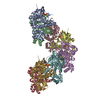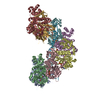+Search query
-Structure paper
| Title | RAD51 protects abasic sites to prevent replication fork breakage. |
|---|---|
| Journal, issue, pages | Mol Cell, Vol. 84, Issue 16, Page 3026-3043.e11, Year 2024 |
| Publish date | Aug 22, 2024 |
 Authors Authors | Yodhara Wijesekara Hanthi / Miguel Angel Ramirez-Otero / Robert Appleby / Anna De Antoni / Luay Joudeh / Vincenzo Sannino / Salli Waked / Alessandra Ardizzoia / Viviana Barra / Daniele Fachinetti / Luca Pellegrini / Vincenzo Costanzo /    |
| PubMed Abstract | Abasic sites are DNA lesions repaired by base excision repair. Cleavage of unrepaired abasic sites in single-stranded DNA (ssDNA) can lead to chromosomal breakage during DNA replication. How rupture ...Abasic sites are DNA lesions repaired by base excision repair. Cleavage of unrepaired abasic sites in single-stranded DNA (ssDNA) can lead to chromosomal breakage during DNA replication. How rupture of abasic DNA is prevented remains poorly understood. Here, using cryoelectron microscopy (cryo-EM), Xenopus laevis egg extracts, and human cells, we show that RAD51 nucleofilaments specifically recognize and protect abasic sites, which increase RAD51 association rate to DNA. In the absence of BRCA2 or RAD51, abasic sites accumulate as a result of DNA base methylation, oxidation, and deamination, inducing abasic ssDNA gaps that make replicating DNA fibers sensitive to APE1. RAD51 assembled on abasic DNA prevents abasic site cleavage by the MRE11-RAD50 complex, suppressing replication fork breakage triggered by an excess of abasic sites or POLθ polymerase inhibition. Our study highlights the critical role of BRCA2 and RAD51 in safeguarding against unrepaired abasic sites in DNA templates stemming from base alterations, ensuring genomic stability. |
 External links External links |  Mol Cell / Mol Cell /  PubMed:39178838 PubMed:39178838 |
| Methods | EM (helical sym.) |
| Resolution | 3.2 - 3.4 Å |
| Structure data | EMDB-19050, PDB-8rcd: EMDB-19051, PDB-8rcf: |
| Chemicals |  ChemComp-ATP:  ChemComp-CA: |
| Source |
|
 Keywords Keywords | DNA BINDING PROTEIN / Homologous recombination / DNA replication / abasic DNA |
 Movie
Movie Controller
Controller Structure viewers
Structure viewers About Yorodumi Papers
About Yorodumi Papers







 homo sapiens (human)
homo sapiens (human)